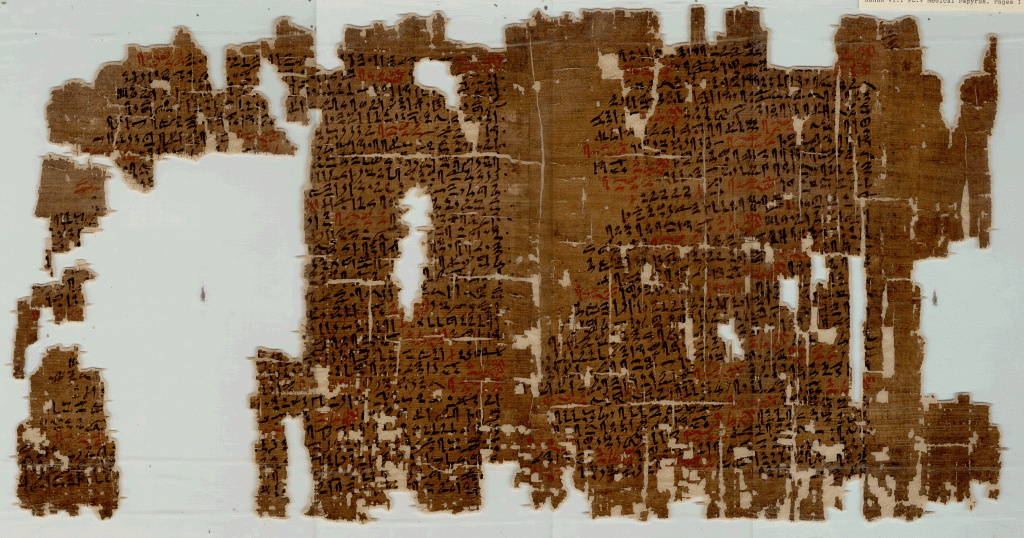Winner of the Fall 2017 StMU History Media Award for
Best Article in the Category of “Gender Studies”
Best Overall Research
For most of modern memory, the predominant belief was that sex was for procreation, and that pleasure was a sin.1 As a result, members of modern society tend to assume that contraception is a fairly recent practice. Yet, contrary to popular belief, many ancient societies believed in sex for pleasure. For instance, some of the earliest medical writings show contraception played a role in Egyptian society.2 Some question the efficacy of the contraceptive techniques as another method of suggesting that sex for pleasure was not historically possible. But there is little doubt that the reason for the Egyptians’ seeking effective contraception was to permit sex without the concern of procreation, hence sex solely for pleasure. Indeed, sources like the Kahun Papyrus show us that our ancient and pre-modern ancestors knew a good deal about reproduction and effective contraception—proving that Egyptian women had more control over their sexuality in ancient times than many woman have enjoyed since the rise of modern religions.3
The main source of historical evidence that contributes to this debate between contraception and infant mortality, and between magic and medicine, is the Kahun Gynecological Papyrus.4 The Kahun Papyrus was discovered by Petrie Flinders in 1889 in a small village called El-Lahun, one-hundred kilometers south-west of Cairo. It dates to 1850 B.C.E., and is the earliest record of ancient Egyptian medical practices. The papyrus is entirely gynecological in nature and is written in hieratic script, not hieroglyphs. It did not become legible until 1806 after the discovery of the Rosetta stone.5 It is divided into thirty-four sections, each dealing with a specific problem relating to gynecological disease, fertility, contraception, and pregnancy. Three of these fragments are prescriptions that relate specifically to preventing conception, all of which involve vaginal suppositories.6 When Flinders found the papyrus, it was badly damaged with small fragments of text missing.7 These missing fragments keep the debate alive as to how exactly some of these remedies were used.
However, despite the long-held belief among scholars that the relative stability of ancient populations was linked to a high infant mortality rate, there is significant evidence that shows that that was not the case.8 The Kahun Papyrus shows us that Egyptian medical practices were based in fact and knowledge, with only a sprinkling of the supernatural. In his book, Contraception and Abortion from the Ancient World to Renaissance, John Riddle, a leading expert of ancient pharmacology, makes the argument that population stability was not linked to high infant mortality rates. Instead, Riddle asserts that population control was due to the use of herbal contraceptives by women.9 The ancient world held much more knowledge of contraceptives than previously thought.10

The main treatments detailed in the papyrus were founded in Egyptians’ knowledge and observations of herbs, plants, minerals, and the effects these items in nature had on animals. The Egyptians noticed that when animals ate certain plants they failed to reproduce. They carried this observation over into their reproductive techniques. Ingredients listed in the contraceptive techniques include acacia gum, sour milk, crocodile dung, fiber, and honey.11 These ingredients were mixed into a pessary and inserted into the vagina by a swnw, or person who was skilled in the art of healing. The pessary would work to block the sperm from reaching a woman’s fallopian tubes and finding an egg to fertilize. When the method using sour milk was tested, the results showed that the enhancement of the acidic environment of the vagina with the introduction of sour milk establishes an effective spermicide, thus proving that the Egyptians did use medicinal techniques that were based on fact, not simply on fiction.12
The existence of contraceptive treatments reflected within the Kahun Papyrus combined with their demonstrated effectiveness leads to the extrapolation that population control was both a desired and achievable outcome for ancient Egyptians. If John Riddle’s theory that the Egyptians actively prevented pregnancy is correct—and the evidence suggests that it is—then we can conclude that sex was not only for reproduction, but for enjoyment.13 In her book Sexual Deviance and Society, Meredith G. F Worthen asserts that sexual imagery from more than 5,000 years ago has been credited to ancient Egyptian cultures. Although we may see these depictions as pornography, to ancient Egyptians they were just a part of sexual life.14 This could lead to the belief that ancient Egyptians were not exactly modest when it came to sexuality and sexual pleasure. To freely express their sexuality, effective contraceptives were a necessity.

Overall, the evidence directs us to the fact that Egyptians held knowledge about contraceptives and used them to prevent pregnancy. So why is the modern belief that contraceptives are a new invention, rather than several millennia old? The answer lies in the rise of Christianity. Before Christianity found its foothold as a highly influential religion, early humans often equated sexual and religious experiences. Christian hostility to sexuality built steadily in the early centuries of the religion. This hostility produced a new attitude of denunciation of women’s sexuality. Early Christians promoted the narrative that Jesus was not born from normal sexual activity, but from a virgin through immaculate conception. Once the religion gained traction, sexual misbehavior was not only seen as a danger to proper human values, but as an offense to God himself. The prevailing belief was that sex was only allowed in marriage and for reproduction. Christian missionaries eventually held enough influence over governments that they pushed them to add new secular penalties to violations of sexual regulations. Secular laws began to target the use of contraception or any other act preventing birth, in some cases the penalty for these acts was death. Over time, Christianity succeeded in chiseling away at “open” sexuality.15 Though modern society has begun to shed this belief, we still see vestiges of it linger in the way sexuality among woman is described. Women who enjoy sex face negative rebukes across the world. These hostile ideologies explain some scholars’ reluctance to accept the fact that ancient Egyptian women enjoyed sex and actively and effectively engaged in it without the outcome of pregnancy.
“Man has always had a desire to heal and control fertility.”16 This truth does not apply only in modern times as many think; the Kahun Papyrus shows that this desire goes all the way back to at least 1825 B.C.E. Yes, the Egyptians’ medical practices were influenced by religion, but we cannot discount their effective techniques simply because they imbibed those practices with the supernatural. Joshua Mark says that “most people would balk at the idea of visiting a doctor and having incantations muttered over them.”17 Yet, we have long had, and still have, very similar rituals in modern Christian society. Doctors will sometimes use their medical knowledge to treat patients, while also praying for or with them. The Kahun Papyrus can be evaluated the same way. We, as a society are reluctant to accept the fact that women are sexual beings, but the historical evidence proves that women have sought control over their sexual experiences since ancient times. That desire is not new to modern society. Steeped in religion though it may be, the papyrus proves our ancient ancestors developed effective techniques for contraception so they would be free to pursue their sexual desires without the fear of procreation.
- Peter N. Stearns, Sexuality in World History (Madison, NY: Routledge, 2009), 47. ↵
- Gary B. Ferngren, “Eve’s Herbs: A History of Contraception and Abortion in the West,” The New England Journal of Medicine 341, (1997): 1398. ↵
- John Riddle, Contraception and Abortion from the Ancient World to the Renaissance (Cambridge, MA: Harvard University Press, 1992), 67. ↵
- Stephen Quirke, Manuscript for the health of mother and child (London: University of London, 2002), 1-3. ↵
- Chinmoy K. Bose, “The el-Lahun gynecological papyrus,” Hekton International: A Journal of Medical Humanities 9, no.2 (2016), http://hekint.org/the-el-lahun-gynecological-papyrus/. ↵
- John Riddle, Contraception and Abortion from the Ancient World to the Renaissance (Cambridge, MA: Harvard University Press, 1992), 66. ↵
- Chinmoy K. Bose, “The el-Lahun gynecological papyrus,” Hekton International: A Journal of Medical Humanities 9, no.2 (2016), http://hekint.org/the-el-lahun-gynecological-papyrus/. ↵
- Gary B. Ferngren, “Eve’s Herbs: A History of Contraception and Abortion in the West,” The New England Journal of Medicine 341, (1997): 1398. ↵
- Gary B. Ferngren, “Eve’s Herbs: A History of Contraception and Abortion in the West,” The New England Journal of Medicine 341, (1997): 1398. ↵
- Ronit Haimov-Kochman, Arye Hurwitz, Yael Sciaky-Tamir, “Reproduction concepts and practices in ancient Egypt mirrored by modern medicine,” European Journal of Obstetrics and Gynecology and Reproductive Biology 123, no. 1 (2005): 3-8. ↵
- Lesley Smith, “The Kahun Gaynaecological Papyrus: ancient Egyptian medicine,” Journal of Family Planning and Reproductive Health Care 37, no.1 (2010): 54–55. ↵
- Ronit Haimov-Kochman, Arye Hurwitz, Yael Sciaky-Tamir, “Reproduction concepts and practices in ancient Egypt mirrored by modern medicine,” European Journal of Obstetrics and Gynecology and Reproductive Biology 123, no. 1 (2005): 4-5. ↵
- John Riddle, Contraception and Abortion from the Ancient World to the Renaissance (Cambridge, MA: Harvard University Press, 1992), 70. ↵
- Meredith G. F. Worthen, Sexual Deviance and Society: A sociological examination (New York: Routledge, 2016), 140. ↵
- Peter N. Stearns, Sexuality In World History (Madison, NY: Routledge, 2009), 43-48. ↵
- Lesley Smith, “The Kahun Gaynaecological Papyrus: ancient Egyptian medicine,” Journal of Family Planning and Reproductive Health Care 37, no.1 (2010): 54–55. ↵
- Ancient History Encyclopedia, February 2017, s.v “Ancient Egyptian Medical Texts,” Joshua J. Mark. ↵



146 comments
Karina Cardona Ruiz
You did a great job on your article and I can tell a lot of research and time went into writing it: I thoroughly enjoyed reading it. I did not know that there were forms of contraceptives before the late 1900s. I find it very interesting how ancient societies, especially Egypt, were so advanced in different aspects yet we tend to not think of them that way because we compare them to ourselves. It’s great that the Egyptian women were in control of their sexuality and hopefully the women of today and the future will be able to do so without being seen in a negative light.
Stephanie Silvola
This article did great discussing on a topic that could be considered a debatable topic. Sexual relationships are not really discussed along with contraception’s and fertility, but knowing that past civilizations did in fact cover it should make this topic more open. Egypt is widely known for its many god and goddesses and pyramids, but history never really touches on the sexual aspect of women. History should really include past civilization techniques with the ones of the modern times to teach and touch on the subject on pleasure.
Raymond Munoz
I’m not very familiar with the sexual standards of the ancient world. All I really knew is that majority of ancient religions saw any sexual activity for please as a sin. So, it was pretty enlightening to read this article and find out about all the things Egyptian women would do to protect themselves from pregnancy. It is strange to think about how they wanted to protect themselves from pregnancy, when usually when I think of the ancient world I think of women having several babies.
Jose Fernandez
This topic is very interesting because when we think about contraception, we only think about the modern techniques and practices. However, as stated in the article, civilizations throughout history had detailed knowledge about conception and fertility. I would have never guessed that Egyptians used all the contraception methods described in the article. Religions have changed the way society sees sexual relationships, so it is important to know about how it was seen hundreds of years ago.
Mariah Garcia
I find this article to be absolutely fascinating, as the topic covered can be considered a hot-button issue. It is astounding to think that the ancient Egyptian culture utilized such effective methods in order to take the worry out of sexual intercourse, while at the same time finding a solution to a possible population problem. But the most surprising fact that I found in this article was the Kahun Gynecological Papyrus; when thinking of feminine health, one does not think of ancient Egyptian studies and practices as a credible source or as a foundation for such a school of thought.
Christopher Hohman
Nice article. I did not know that women practiced contraception all the way back to ancient Egyptian times. I always thought it originated in the 1920s with the flappers, but I was wrong. The ancient Egyptians clearly enjoyed having sex. They did not have to worry about having children each time either. The methods they use are really strange though. Definitely different then those that we have today.
Esperanza Rojas
This article surprised me with how advanced the Egyptians were with their medical research. The fact that this society didn’t fall into the category of how it ignored the sexuality of a woman, but rather investigated it shows how progressed it was, as a community. The experiments with the sour milk, honey, and fiber was such a neat thing i never knew. The way it was tested kind of threw me off, but of course with no technology, there was no other way it could done. I’m glad people were able to discover these writings, it is able to show a different side of history.
Luis Magana
It surprises me how they used contraceptive methods for the purpose of pleasure and engage in sexual activity. Humans are sexual beings and sometimes pregnancy wants to be prevented. and the ancient Egyptians did that effectively. they were smart enough to control their fertility and their population. its funny how some of the contraceptives were sour milk and crocodile dung. something that was common in that point in time is still common to this day, people protect themselves from pregnancy.
Steven Hale
Since I have witnessed societal attitudes towards women and their sexuality evolve and progress over the last ten years, it is easy for me to assume that the farther back in time we look, the worse things were for women. Your article clearly shows that such an assumption is not true. This article is also the second where I have been surprised by the Egyptian’s medical knowledge. As new forms of contraception are still being developed and enhanced today, it is incredible to think that an ancient society both discovered and regularly used them.
Mia Stahl
Egyptians have been said to be one of the few ancient societies that existed under a strongly matriarchal society. So the headline of this article naturally sparked my interest but the information in the article was something that I have heavily considered in my higher education. The healthy sexual relationship that women had with themselves is no surprise to me and the contraception tendencies play a larger roll in their ability to maintain this healthy relationship.